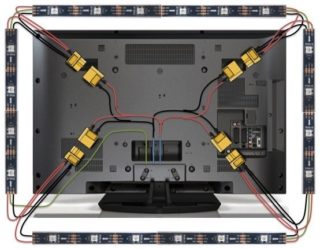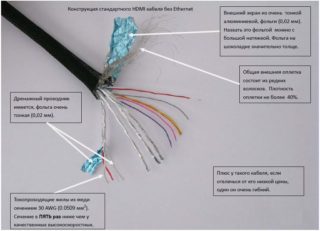In the electrical materials market, in addition to wires with standard Russian markings, cables with the AWG designation are often found. Conductors of this class are designed to solve specific problems and have individual technical characteristics.
American wire gauge

The abbreviation AWG itself is of American origin and stands for American Wire Gauge, which translates as "American Wire Gauge". It does not indicate the diameter of the inner conductors in millimeters, which is familiar to us, but the number of cable runs through the forming machine in the production process.
For example, a 24 AWG wire has a smaller core diameter than a 22 AWG conductor, since the first cable was passed through the molding machine 24 times and the second only 22 times.
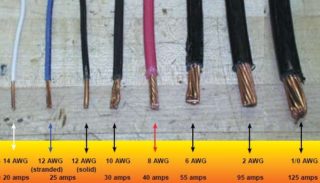
Sizing, according to the presented standard, differs slightly from the standard nomenclature of diameters in millimeters. Conversion to the usual dimensions of a single-core conductor and a stranded one is performed according to different formulas.
The AWG standard itself concerns not only power cables and wires used in the arrangement of electrical wiring. It is also used in the digital industry such as marking HDMI and USB cables, twisted pairs, etc.
Where did the AWG marking come from?
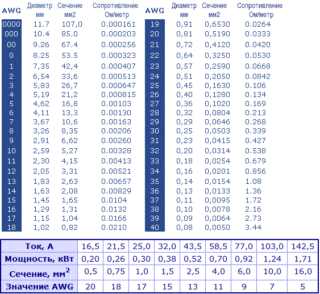
The shape of the cable cores is similar to conventional copper wire.
In the United States, wire was previously produced according to the drawing (pulling) principle. For this, the workpiece was passed through the rollers of the machine. For example, there is a workpiece with a cross-sectional index of 12 mm. To reduce its diameter to the required one, the wire was pulled through the calibration hole a specific number of times, as a result of which it was stretched, the length indicator increased, and the diameter indicator decreased. So from the 12th diameter it was possible to make the 10th or 8th.
Each subsequent broaching procedure lowered the section and added one to the AWG value. At the start of the process, a workpiece with the largest gauge AWG 0 (corresponding to the thickest cable) is used. With one wire feed, the AWG value will be 1. If the workpiece is passed through the machine twice, the AWG value will be 2, and so on.
The largest calibers larger than AWG 0 are designated AWG 00, AWG 000, etc.
This marking is mirrored in relation to the Russian one. We got used to the fact that the larger the number, the larger the cross-section of the conductors. Here, everything is different - the larger the caliber value, the smaller the diameter of the conductors.
In which countries are used
In addition to the creators, the presented standard is actively used by Japan and China.
The states of Europe, the countries of the former CIS and Russia use a different measurement system - mm2.
In addition, the United States does not use such a measuring unit as the millimeter at all. In literally every technical field, an inch is used, referred to as inch.
Applications of cables
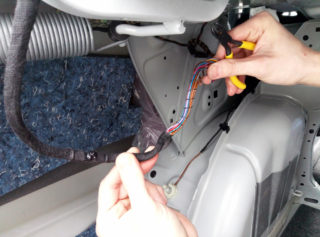
AWG cables are commonly called twisted pair cables, since their cores are twisted in pairs and form a solid wire. There are many industries using such cables.
The main ones are:
- Electrical supply of outlet networks and diode lamps in residential and industrial premises.Often, the current in such lines does not exceed 24V, and the most common voltage is 12V. Such a scheme makes it possible to reduce energy costs and is safer than 220V lines.
- Arrangement of wiring in the field of telephony and communications, for example, as lines for connecting to the Internet or local networks.
- Virtually all electrics in vehicles are AWG cables with different calibers. The most commonly used is 23 AWG longitudinal twisted pair, where the conductor can be either solid or stranded. Battery power is supplied to the starter and motor using thicker 16 AWG wires.
- Music centers and televisions also use these conductors. For example, headphones and microphones use 22 or 24 AWG twisted pair, the section in mm of which will be indicated below.
- Smallest gauge cables, less than 26 AWG, are used in car alarms, temperature sensors for gas or electric boilers, as well as in automatic fire extinguishing systems. They do not withstand high voltage, but for networks with a small current value they are the best option. For example, 28 AWG wires are used extensively in car airbag contactors. The 30 AWG cable is commonly used in internet connection receptacles.
It is strictly forbidden to connect low-current type wires to a stationary 220V / 380V network. This will inevitably lead to a short circuit.
All of the above industries of application of wires are key, in practice there are much more of them. In these industries, conductors of non-standard calibers are often found, performing functions of data transmission.
Low-voltage networks do not pose a threat to humans and animals. The impact of such a current is literally not felt by the human body; such networks are the safest and are used in astronautics and other technical industries. Even during open contact with bare cores, a person does not feel an electric shock, so repair work can be performed without disconnecting the network.
Fiber-optic cables made using US technology and marked as 24 AWG (in mm equals 0.644) are actively used. Such networks are pulled both external and underground. They are designed to transfer data at high speeds.
Cable design and composition
First of all, this applies to single-core conductors with different base thicknesses and an outer insulating layer made of expanded polypropylene. The core can be braided and made up of several layers of aluminum or copper conductors twisted in a spiral manner. Their thickness indicator directly affects the degree of current resistance - the larger the number of cores and the indicator of their thickness, the weaker the resistance value and the loss per meter of the conductor will be. Also, this value affects the degree of heating of the metal at increased loads. Large-caliber conductors are more resistant to heat, which significantly extends the life of common lines.
Stranded wire AWG
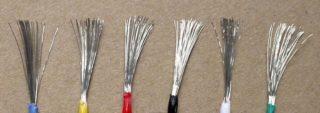
Stranded wires by their design are somewhat more complicated, therefore, it is extremely difficult to make the correct calculation of a load that is comfortable for them. It is necessary to build on the characteristics of one core and calculate the coefficient ratio.
The cables themselves, the caliber of which is indicated by the number before the abbreviation AWG, can be cylindrical or triangular braided into a single rod. Due to the elasticity of the metal, the wire can be twisted at various angles, which is very convenient for installation work in hard-to-reach points, for example, wall cable channels.
The insulating layer made of polypropylene or PVC also has high flexibility and perfectly withstands mechanical stress when sifting the soil or deformation of a part of the line. The insulation is absolutely dielectric, therefore, even when the cable bundles are connected to each other, a short circuit is excluded.
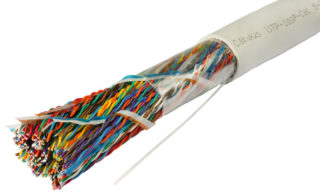
In separate twisted optical fiber pairs, excluding the standard cladding, there is a reinforcing thread between the core and the insulating layer, which is twisted in a spiral. It gives the products strength even when twisted. This insulation prevents the wires from stretching, constantly returning the core and outer layer to acceptable levels.
A separate class should include television cables for transmitting a signal from an antenna or an amplifier. These conductors have a copper core which is sealed in polyethylene foam. From the center of the cable to the edge, a foil sheath is located, which is responsible for the delivery of negative particles. The outer layer is PVC insulation that tightly fits the entire product. The conductor is assembled using special metal adapters with a tightening device. They securely fix the wire and guarantee precise contact.
Copper conductors are more durable than aluminum conductors. Therefore, their service life is longer. They are less susceptible to wear from mechanical influences, but the cost of such products is also higher.
Conversion table of cable and AWG wire to millimeters
In order not to recalculate the caliber of each conductor by the diameter in square millimeters on a calculator, you can resort to using a table with ready-made numbers:
| Caliber | Diameter mm | Cross section mm2 |
| 0000 | 11,68 | 107 |
| 000 | 10,40 | 85 |
| 00 | 9,26 | 67,4 |
| 0 | 8,25 | 53,5 |
| 1 | 7,34 | 42,4 |
| 2 | 6,54 | 33,6 |
| 3 | 5,82 | 26,7 |
| 4 | 5,18 | 21,2 |
| 5 | 4,62 | 16,8 |
| 6 | 4,11 | 13,3 |
| 7 | 3,66 | 10,5 |
| 8 | 3,26 | 8,37 |
| 9 | 2,90 | 6,63 |
| 10 | 2,58 | 5,26 |
| 11 | 2,30 | 4,17 |
| 12 | 2,05 | 3,31 |
| 13 | 1,82 | 2,62 |
| 14 | 1,62 | 2,08 |
| 15 | 1,45 | 1,65 |
| 16 | 1,29 | 1,31 |
| 17 | 1,15 | 1,04 |
| 18 | 1,02 | 0,82 |
| 19 | 0,91 | 0,65 |
| 20 | 0,81 | 0,51 |
| 21 | 0,72 | 0,41 |
| 22 | 0,64 | 0,32 |
| 23 | 0,57 | 0,25 |
| 24 | 0,51 | 0,20 |
| 25 | 0,45 | 0,16 |
| 26 | 0,40 | 0,12 |
| 27 | 0,36 | 0,10 |
| 28 | 0,32 | 0,08 |
| 29 | 0,28 | 0,06 |
| 30 | 0,25 | 0,05 |
| 31 | 0,22 | 0,04 |
| 32 | 0,20 | 0,03 |
| 33 | 0,18 | 0,02 |
| 34 | 0,16 | 0,0201 |
| 35 | 0,14 | 0,016 |
| 36 | 0,12 | 0,012 |
| 37 | 0,11 | 0,01 |
| 38 | 0,10 | 0,007 |
| 39 | 0,08 | 0,006 |
| 40 | 0,07 | 0,005 |
In the USA, 22 AWG wires are most often used for Internet communication, the cross section in mm of which is 0.644. There is no limit to the maximum gauge for industrial applications, but the most sought-after conductors are 4 AWG and 8 AWG.
Calculation formulas
The formula for converting calibers to millimeters is as follows:
An indicator of 0.005 inches, when converted, is 0.127 mm. The n-value is the caliber nomenclature. The presented formula is valid only for solid conductors of cables and wires.
The values "36", "39" and "92" are present in the formula for a reason. In the late 90s, the AWG, which has a diameter of 0.005 inch, was matched with a 36 gauge. In those years, this was the thinnest wire. The thickest cable was AWG 0000. The ratio between the smallest and largest diameter is exactly "92".
The calibration range, starting at AWG 36, consists of 38 consecutive calibers and the ratio between them is constant. The ratio between adjacent calibers is 1.1229. This number is the 39th root of the number 92.
For large calibers, the “n” is a negative indicator - (m-1).
Rules of thumb
The sixth level of the ratio of the diameters of two adjacent gauges AWG is extremely close to 2 (2.005), which dictates the following rules:
- Doubling the cable diameter reduces the gauge by 6 notches.
- Doubling the cross-section of the cable entails a decrease in the caliber by 3 units.
- Decreasing the gauge by 4 units doubles the melting current of the cable.
Lowering the caliber by 10 units increases the area and mass by approximately 10 times and reduces the degree of resistance by approximately 10 times.
Operating conditions
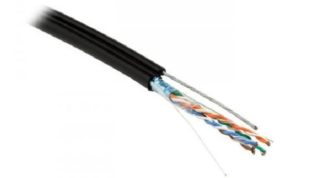
AWG cables have the same insulation layer and outer jacket as traditional metric wires. When installing products and their operation, you must follow the basic rules:
- During the laying of the line in the ground, it is impossible to install conductors without a protective corrugation or asbestos sleeve.
- When tensioning the wires between the supports, it is necessary to use guide cables that relieve tension from the conductors.
- If the cable is laid on the bottom of the reservoir, its connections must be carefully insulated with polyethylene foam.
You can not apply to the conductors a voltage greater than its specific rating - it is fraught with overheating and short circuit.

